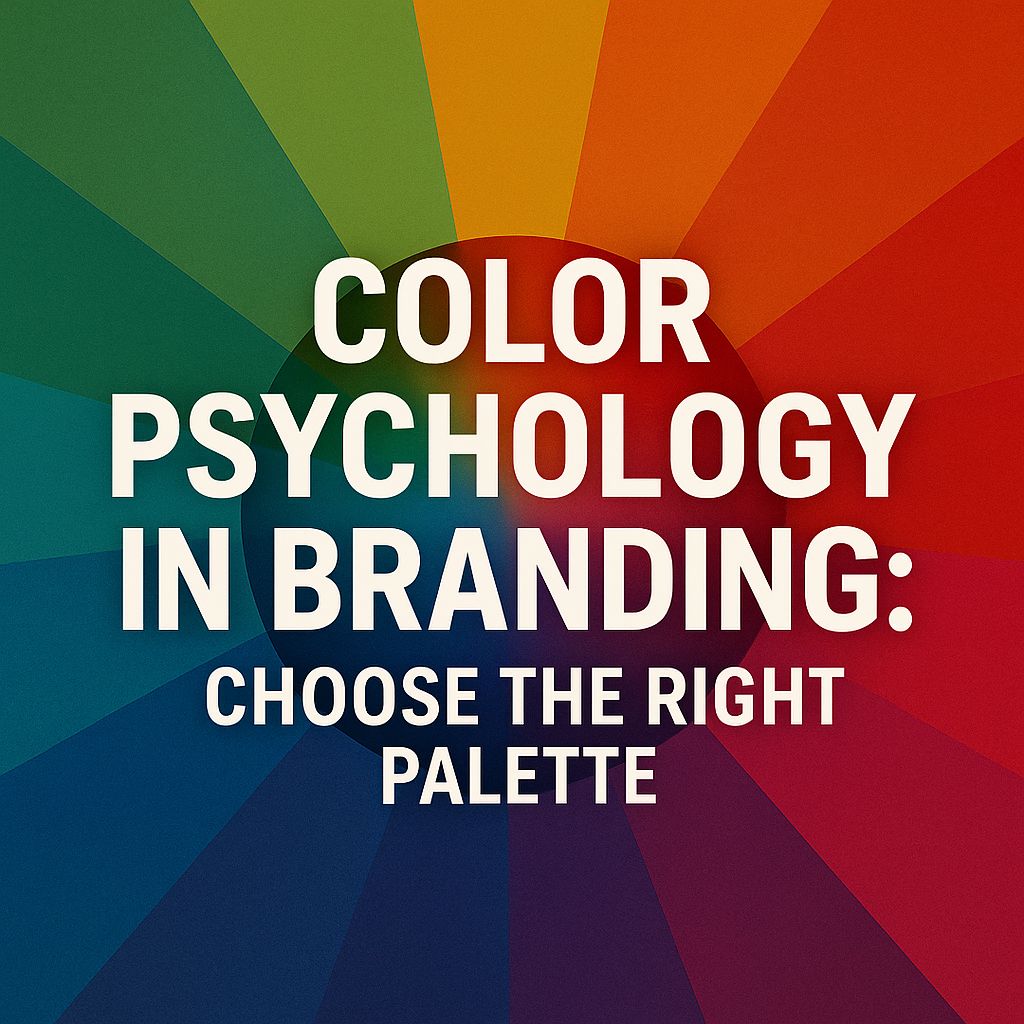Introduction
Open any app you love, pass a billboard you remember, or unbox a product that felt “right,” and you’ll notice something quietly doing heavy lifting: color. The colors in your logo, website, ads, and packaging are not decoration; they’re signals that shape memory, trust, and desire. This is where color psychology in branding becomes a strategic advantage, not a design afterthought.
At Text & Arts Solutions, we obsess over how small choices change big outcomes. After working for six years in translation across sectors—from education and banking to tech and lifestyle—I (the author) learned first-hand that nuanced human judgment is essential. In Hindi and other Indian languages, a literal translation often fails because context changes meaning. Colors behave the same way: their impact shifts with culture, category, contrast, and context. A palette that soars in one market can feel off in another. The “human touch” that makes translations resonate is the same touch that makes brand colors convert.
In this guide, you’ll learn how to choose and use palettes with intent—anchored in color psychology in branding—so your designs persuade ethically and perform measurably.
1: The Foundations—What Color Psychology Really Means
Color psychology is the study of how colors influence human perception and behavior. In branding and graphic design, it’s less about one universal emotion per color and more about probabilistic tendencies shaped by culture, context, and category. Think of it as evidence-informed art: color sets expectations, encodes meaning, and directs attention.
1: How Colors Influence Brand Perception (and Why Context Wins)
Common tendencies (remember: context matters):
- Blue: reliability, security, competence; widely used in BFSI and tech because it feels stable.
- Red: energy, urgency, appetite; great for CTAs and limited-time offers, risky for luxury serenity.
- Green: growth, wellness, sustainability; strong for FMCG, agritech, health, and fintech “go” moments.
- Yellow/Orange: optimism, friendliness, speed; powerful for youth brands and price-led promos.
- Purple: creativity, premium, spirituality; often used for beauty, education, and innovation cues.
- Black/Charcoal: luxury, focus, authority; strong for fashion and D2C premium electronics.
- White/Neutrals: clarity, modernity, calm; best for whitespace that elevates hierarchy.
But these tendencies shift. A “safe” blue can feel cold if your category is driven by warmth (e.g., home-cooked food). A bold red can feel urgent in finance (good for offers, bad for reassurance). The job is not to memorize a color dictionary; it’s to map meaning to mission.
Use color to:
- Signal your promise (trust, speed, luxury, care).
- Guide attention (CTA buttons, forms, price tags).
- Create recognition (consistent palette across touchpoints).
- Shape hierarchy (headlines vs. body, primary vs. secondary actions).
2: Myths, Limits, and Ethical Use
- Myth: “Red means danger everywhere.”
Reality: In sales, red CTA can increase urgency; in luxury wellness, it can feel jarring. - Myth: “One palette fits all markets.”
Reality: Cultural symbolism changes everything (see India-specific notes below). - Myth: “Color psychology equals manipulation.”
Reality: It’s about clarity and fit. Ethical design reduces friction and anxiety. - Limit: “Exact color guarantees exact behavior.”
No. Color influences, it doesn’t determine. Copy, layout, timing, and product quality matter. - Accessibility is not optional.
Visual contrast affects everyone: those with low vision, mobile glare, or fatigue. Target at least 4.5:1 contrast for body text (3:1 for large text). Color should not be the only channel for meaning (use labels, icons, patterns).
2: Building Your Palette—Theory, Culture, and the Indian Context
A great palette balances meaning, harmony, contrast, and consistency. Start with the basics, then layer in cultural nuance—especially important for brands that speak to Indian audiences in multiple languages.
1: Color Theory You’ll Actually Use
- Hue, Saturation, Value (HSV)
- Hue: the “color” (red, blue, green).
- Saturation: intensity (muted vs. vivid).
- Value: lightness/darkness (tints vs. shades).
Shift saturation and value to move a color’s mood without abandoning its brand identity.
- Temperature (Warm vs. Cool)
- Warm (reds/oranges/yellows): energetic, extroverted, promotional.
- Cool (blues/greens): calm, competent, reassuring.
Mix intentionally: cool backbone + warm accents often works well for conversion.
- Harmony Rules You’ll Reach For
- Monochromatic: one hue, varied values—minimal, premium.
- Analogous: neighbors on the wheel—cozy, cohesive.
- Complementary: opposites—high contrast; great for CTAs.
- Split-Complementary: softer alternative to complements; safer balance.
- Role-Based Palette Planning
- Primary: 1–2 core brand hues (logo, headers, key surfaces).
- Neutrals: grayscale/taupe range for backgrounds and text.
- Accent: 1–2 highlight colors for CTAs, badges, charts.
- States: success/warning/error/info tones for product UI.
- The 60–30–10 Rule
- 60% dominant base, 30% secondary, 10% accent.
- Useful starting ratio—adapt for UI where states and accessibility dictate usage.
- Print vs. Digital
- Digital: RGB/Hex; Print: CMYK/Spot (Pantone).
- Create conversion notes: specify Pantone equivalents, define tolerances (ΔE) for vendors.
- Design Tokens
- Name colors by role (e.g.,
color.bg.surface,color.text.primary,color.cta.default) so you can swap values without breaking the system.
- Name colors by role (e.g.,
2: Cultural Nuance—Designing for India (and Why Language Matters)
From six years in translation, I learned that literal meaning breaks without context. The same is true for color across India’s regions and languages:
- Saffron/Kesari: sacrifice, courage, spirituality; also strong national symbolism.
- Green: growth, prosperity, environment; part of the Indian flag; sensitive in interfaith contexts—use respectfully.
- White: purity and peace, but also mourning in some traditions. Balance with accent colors to avoid somberness.
- Red: auspiciousness, celebration (weddings), power; also risk/alert in UI.
- Gold: wealth, auspiciousness, festivities; strong in jewelry/finance/ceremonial cues.
- Black: sophistication and focus; can carry inauspicious associations in some contexts—test messaging carefully.
- Blue: trust, depth, technology; also carries cultural references (e.g., Krishna), which can feel familiar and warm.
Regional cues & language naming:
- What North Indian consumers call “mehndi green” might be imagined differently in the South; “rani pink” is vivid and festive but not universal across categories.
- In bilingual designs (Hindi + English or other Indian languages), copy tone and color must align: a cheerful orange headline with serious compliance text in Hindi can feel mismatched.
Actionable tips:
- Create culture notes in your brand book: “Red = festive; UI alert uses a deeper, cooler red to avoid celebratory connotations.”
- Build market-specific accents for festive campaigns (e.g., gold/vermillion for Diwali offers, pastel florals for spring categories).
- Run language + color reviews: the way a word feels in Hindi/Marathi/Tamil may alter how a color is perceived alongside it—just like translations, colors need a human check.
3: From Strategy to Execution—A Step-by-Step Workflow
Here’s a practical blueprint to choose the right palette, blending color psychology in branding with research, testing, and governance.
Step 1: Clarify Positioning and Promise
Write a one-line brand promise: “We make investing feel calm, transparent, and empowering for first-time users.” Circle three attributes (e.g., calm, modern, trustworthy). These adjectives will steer your color choices.
Step 2: Audit Category Codes (Decide When to Fit or Break Them)
- BFSI: blues, teals; occasional red accents for alerts.
- Beauty: pastels, muted neutrals, lilacs; high aesthetic polish.
- Food: saturated reds/oranges/yellows for appetite, or earthy tones for organic.
- Health: greens/teals, soft blues; clean whites for care.
Choose to echo codes (for fast comprehension) or subvert them (for differentiation). Document why.
Step 3: Map Emotions to Roles
- Core brand color(s) → promise + recognition.
- Accent(s) → energy/urgency/delight.
- States → clarity of feedback (success/alert/error/info).
Keep a single source of truth: “Accent Red is for offers and CTAs, never for warnings.”
Step 4: Draft a Shortlist (3–5 Palettes)
For each candidate palette, define:
- Primary hex (with tints/shades).
- Secondary hex (with tints/shades).
- Accent hex (with hover/active states).
- Neutral scale (text, border, disabled).
Create quick mockups: hero banner, landing page, CTA button, form, and an Instagram tile.
Step 5: Check Accessibility Early
- Body text contrast ≥ 4.5:1; large text (18pt regular / 14pt bold) ≥ 3:1.
- Don’t rely on color alone for meaning—add icons/labels (e.g., ✓ for success).
- Simulate low-vision modes and sun glare. If it fails, adjust saturation/value.
Step 6: Test With Real Users (and Real Languages)
- A/B test CTA colors (e.g., teal vs. orange) across identical layouts.
- Test in multiple languages (Hindi + English + regional), because copy length and tone shift how colors feel.
- Ask emotion-based questions: “Does this feel trustworthy?” “Is the CTA inviting or aggressive?”
Step 7: Stress-Test Across Touchpoints
- Mobile, desktop, print collateral, packaging, signage, dark mode.
- Festive campaigns: can colors scale to “celebratory” without losing identity?
- Data viz: do chart colors remain distinguishable for color-blind users?
Step 8: Decide and Document (Design Tokens + Brand Book)
- Codify tokens:
color.brand.primary.700,color.cta.bg.default,color.text.muted. - Include do/don’t examples, cultural notes, and language pairing guidance (e.g., how Hindi headlines look on the brand gradient).
Step 9: Train the Team (Designers, Writers, Marketers, Vendors)
- Share why choices were made—this prevents random “creative” deviations later.
- Provide a “campaign color kit” for seasonal work so everyone stays on-brand.
Step 10: Govern and Iterate
- Quarterly palette reviews: check performance and inclusivity.
- Maintain a log: when did we tweak the CTA from orange to teal, and why?
- Tie changes to metrics (CTR, conversion, time on page, NPS).
Mini Case Studies (Patterns You Can Reuse)
1) BFSI/Fintech—Calm Confidence
- Goal: reassure first-time investors; simplify decisions.
- Palette: Deep navy primary (trust), soft teal secondary (freshness), emerald success, amber warning, crimson error, neutral grays.
- Why it works: Cool backbone (competence), controlled accents for clarity.
- Notes: Avoid celebratory reds for alerts; keep reds cooler and darker.
2) D2C Food—Warm, Fresh, Honest
- Goal: appetite + authenticity.
- Palette: Earth terracotta base, leaf green secondary, sunny yellow accent for offers, natural off-white surfaces.
- Why it works: Warmth signals taste; green suggests farm-fresh; yellow drives click intent.
3) Beauty & Personal Care—Premium Ease
- Goal: premium yet kind.
- Palette: Soft lavender primary, charcoal text, rose accents, pearl backgrounds.
- Why it works: Low-saturation hues feel modern and calming; charcoal keeps text readable and luxe.
4) B2B Tech—Clarity and Momentum
- Goal: credible innovation, not chaos.
- Palette: Royal blue primary, electric cyan accent for CTAs/links, graphite neutrals, green success states.
- Why it works: Blue = stability; cyan gives forward motion without shouting.
5) Text & Arts Solutions—Example of Strategic Contrast
Our own communications often lean on navy (#02084B) as the primary (authority, clarity) with orange (#FFBD59) as the accent (warmth, approachability). This balance mirrors how we work: rigorous strategy (navy) delivered with creative energy (orange). In bilingual creatives (English + Hindi), we test that the tone of voice aligns with the color mood—because, as translation taught us, meaning lives in context.
Transcreation insight: When a Hindi headline evokes warmth and community, pairing it with a harsh neon accent can feel culturally off. We prefer confident, saturated accents that read as welcoming in both languages, then validate choices with audience tests.
Practical Do/Don’t Checklist
Do
- Use one accent for conversion and stick to it.
- Define light/dark modes and test both.
- Include cultural notes in the brand book.
- Document contrast ratios and state colors.
- Name tokens by role, not by hue.
Don’t
- Change CTA color per campaign.
- Use red for both “celebrate” and “error” without tint/temperature distinctions.
- Rely on color alone to communicate status.
- Assume a palette that works in English will feel the same paired with Hindi copy.
- Forget print equivalents (Pantone/CMYK) and vendor guidelines.
4 (CTA): Design With Color, Communicate With Culture
If you want a palette that performs—not just pleases—partner with a team that designs for behavior and with context. At Text & Arts Solutions, we combine:
- Brand Identity & Graphic Design: research-backed palettes, logo systems, and guidelines.
- UI/UX & Design Systems: accessible tokens, dark mode, and component states.
- Content + Transcreation (English, Hindi, and Indian languages): color choices that match linguistic tone and cultural nuance.
- Motion Graphics & Marketing Creatives: campaign kits with consistent color logic.
Let’s map your promise to a palette that persuades—across languages, platforms, and seasons. Ready for a 30-minute strategy call? Tell us your goals; we’ll bring the color, context, and craft.
Conclusion
Color is not a magic spell; it’s a strategic system. When you ground your choices in color psychology in branding, you create recognition, reduce friction, and increase conversion—without resorting to gimmicks. The most effective palettes emerge from a repeatable process: clarify your promise, respect cultural nuance (especially in Indian contexts), design for accessibility, test with real users, and govern with design tokens and brand rules.
My years in translation taught me that meaning is relational: a word in Hindi succeeds when the human touch makes it resonate in context. Colors are no different. The right palette is meaningful because it fits your audience, category, and culture. Do that consistently, and your brand won’t just look good—it will feel right, behave clearly, and perform better across every touchpoint.
Bottom line: Treat color as a decision, not decoration. Use color psychology in branding to build a palette that tells the truth about your brand—and helps the right people say “yes.”


